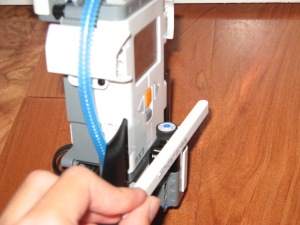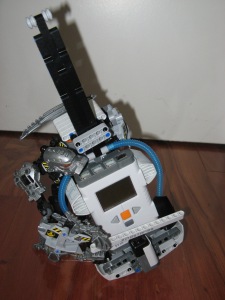Hello! I have returned with a fun new project, the MicroBass. The MicroBass is a musical instrument, drawing inspiration form Daniele Benedettelli’s EL3CTRIC GUITAR, and my entry into the MicroBot building challenge. It is a 33 cm tall replica of a double bass, an instrument normally 2 meters tall! (I play the double bass). In the following sections, I will be explaining the cool features of the MicroBass and how they work. Updates: -7/8/2014: LDD updated, slider mechanism reinforced
See a video of the MicroBass here: https://www.youtube.com/watch?v=aErU57yYqXg
Bowing
For those of you who do not know, the double bass is a bowed instrument, so it was imperative to be able to bow on the MicroBass; and you can!!! On a real life bass, a bow is drawn across a string, which makes the string vibrate and produce sound. The bow for the MicroBass can be any studless Technic beam; a 15 stud beam is used. Since the MicroBass lacks strings, the bow is instead drawn across a small wheel. The bow rotates the wheel, which turns the HiTechnic Angle sensor. When the sensor detects rotation, a signal is sent to the NXT to produce sound. If you draw the bow slowly, the NXT will emit a soft sound, but if you move the bow quickly, the Angle sensor will detect the increased speed and signal the NXT to produce a louder sound. This principle will also work on any bowed string instrument (double bass, cello, viola, violin, etc.).
Playing Notes
What fun is having a musical instrument that only plays one note? The MicroBass is programmed to play notes from E4 to B6 (12 notes), in the key of A minor / C major. (There are no chromatic notes; only “natural” notes.) The range of notes on the MicroBass is the same as that of a real bass if you only played on the “E” string. To play notes, one would place their thumb under the slider at the back of the neck and slide the slider up or down the neck while bowing. The Ultrasonic sensor on the back of the bass body detects the position of the slider and dictates which note to play. Each note is spaced one centimeter from the last. The lowest note on the MicroBass is E4, played with the slider at the very top of the neck. As you move the slider down the neck, the notes will become higher pitched until you reach B6, the highest note, at the base of the neck. The recommended playing position is shown at the left, along with the neck and the slider and the program.
Other Fun Features
The MicroBass has a few extra fun touches that make it even more like a real bass. First, the MicroBass features a decorative scroll at the top of the neck. The MicroBass also features a rubber endpin. Lastly, the black and white plates and blue tubing give the MicroBass an authentic-looking silhouette. One not-so-realistic feature; the MicroBass can stand on its own, albeit on an angle.
Conclusion
I built and programmed the MicroBass in a few hours, which is a refreshing change from the month or so it took me to make the Plethora II. (If you haven’t seen it yet, I suggest you go see it!) The MicroBass is unlike anything I’ve done before, with its small size, smaller part count and the fact its the first time I’ve built a musical instrument. The building instructions are available and you can build the MicroBass with the EV3 or NXT 2.0 sets, + a HiTechnic Angle sensor. I would have liked to include the program, but this site has been giving me a hard time lately. Maybe in the future I will create new programs that will allow me to play in more key signatures. I hope you enjoyed the MicroBass; thanks for reading!






